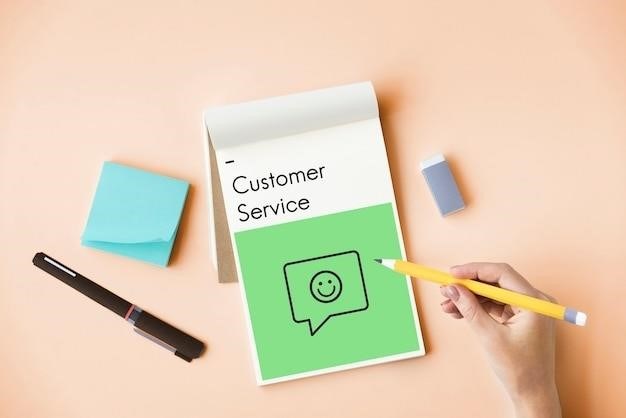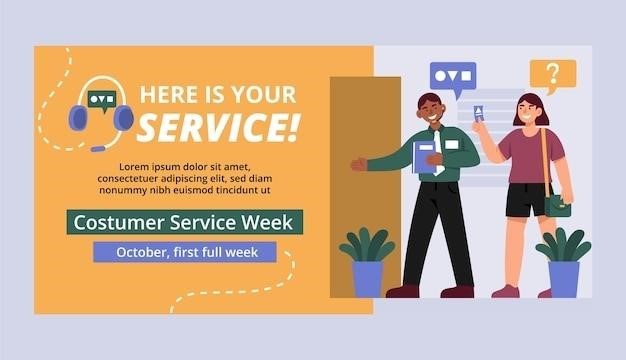Perfect Phrases for Customer Service⁚ A Guide to Effective Communication
This guide explores the essential elements of effective customer service communication. We delve into the importance of using the right words and phrases to build rapport, resolve issues, and ultimately create a positive customer experience.
Introduction
In today’s competitive business landscape, exceptional customer service is no longer a luxury but a necessity. It’s the cornerstone of building customer loyalty, driving positive word-of-mouth, and ultimately, achieving business success. While providing excellent service involves various aspects, communication plays a pivotal role. The phrases we choose to use can significantly impact how customers perceive our service and our brand. This guide provides a comprehensive exploration of powerful phrases for customer service, offering practical insights into crafting impactful communication that resonates with customers and builds lasting relationships.
Importance of Customer Service Phrases
The right customer service phrases can be a powerful tool for building trust, resolving issues, and creating a positive experience for customers. These phrases act as building blocks for effective communication, fostering a sense of understanding, empathy, and professionalism. Using the right language can help defuse tense situations, build rapport, and demonstrate that you genuinely care about the customer’s needs. Furthermore, positive and helpful phrases leave a lasting impression, contributing to a positive brand perception and a more loyal customer base. In essence, the language we use in customer service is not just about conveying information; it’s about creating a connection, building relationships, and ultimately, achieving a higher level of customer satisfaction.
Types of Customer Service Phrases
Customer service phrases can be categorized into different types, each serving a specific purpose in guiding the interaction. Greeting phrases set the tone for the interaction, establishing a welcoming and professional atmosphere. Problem-solving phrases demonstrate a proactive approach to understanding and resolving customer concerns. Apology phrases, when used sincerely, acknowledge errors and demonstrate a willingness to make things right. Finally, closing phrases provide a sense of closure and ensure that the customer feels heard and their needs have been addressed. By strategically utilizing these types of phrases, customer service representatives can navigate a wide range of interactions effectively, building trust and ensuring a positive customer experience.
Greeting Phrases
Greeting phrases are the initial point of contact, setting the stage for a positive customer interaction. A simple “Hello, how can I help you today?” conveys a welcoming and helpful attitude. “Good morning/afternoon,” combined with the customer’s name if available, adds a personal touch. “Thank you for contacting us,” acknowledges the customer’s effort to reach out. When addressing specific needs, “I’m happy to assist you with that” or “Let’s see how we can resolve this” demonstrate a willingness to go the extra mile. By choosing appropriate greeting phrases, customer service representatives can create a positive first impression and make customers feel valued from the very beginning of the interaction.
Problem-Solving Phrases
Problem-solving phrases are crucial for demonstrating empathy and proactive solutions. When a customer expresses a problem, phrases like “I understand your frustration” or “I can see how this is a concern” acknowledge their feelings. “Let me see what I can do” or “I’ll do my best to find a solution” convey a commitment to finding a resolution. “I’m here to help in any way I can” offers support and reassurance. To show initiative, use phrases like “I’ve checked the details” or “I’ve spoken to the relevant team,” indicating that you’re actively working on the problem. “This is the best option we can offer at this time” provides a clear understanding of available solutions, while “I’ll keep you updated on the progress” assures customers that they’re informed throughout the process.
Apology Phrases
Apology phrases are essential for acknowledging mistakes and demonstrating professionalism. Instead of generic apologies, focus on specific actions or situations. “I apologize for the inconvenience this has caused” shows empathy for the customer’s experience. “We understand this is frustrating” acknowledges the customer’s emotions. “We’re working to improve our process to prevent this from happening again” demonstrates a commitment to learning from mistakes. When offering solutions, use phrases like “I’d like to offer you a [discount/credit/replacement]” or “I’m happy to expedite the process.” Avoid blaming individuals or departments, instead focus on the company’s responsibility for the error. A sincere apology, coupled with clear action, can help restore customer trust and goodwill.

Closing Phrases
Closing phrases should leave a lasting positive impression and reinforce the customer’s satisfaction. Instead of simply saying “goodbye,” consider options that show continued support. “Is there anything else I can help you with today?” or “Please let me know if you have any other questions” demonstrate ongoing availability. A proactive approach can also be helpful⁚ “I’ve noted your account details and will follow up with you next week.” If the interaction was particularly challenging, a phrase like “Thank you for your patience and understanding” shows appreciation for their cooperation. Ending with a positive affirmation like “I’m confident that we’ve resolved this issue to your satisfaction” reinforces a successful resolution. These phrases can leave customers feeling valued and confident in their future interactions with your business.
Essential Phrases for Different Situations
Customer service interactions are dynamic and require a flexible approach. Having a repertoire of phrases tailored to specific situations allows for effective communication and problem-solving. When handling complaints, empathy is key. “I understand your frustration, and I’m here to help resolve this issue.” Offering solutions is crucial. “I’ve checked the availability of your requested item, and it’s expected to be back in stock next week.” Providing information needs to be clear and concise. “Our return policy allows for a full refund within 30 days of purchase.” Resolving issues requires a proactive approach. “I’ve escalated this issue to our technical support team, and they will be contacting you shortly.” Building relationships involves demonstrating genuine care. “I’m here to assist you in any way I can. Please don’t hesitate to reach out if you have any questions or concerns.” By adapting your communication to the specific situation, you can create a positive and productive customer service experience.
Handling Complaints
When faced with a dissatisfied customer, it’s essential to approach the situation with empathy and a problem-solving mindset. Acknowledge their frustration and validate their feelings. “I understand you’re upset about [issue], and I want to assure you that we’re here to help.” Actively listen to their concerns and avoid interrupting. “Please tell me more about what happened so I can get a better understanding of the situation.” Apologize sincerely, even if it wasn’t your direct fault. “I apologize for the inconvenience this has caused.” Offer solutions and alternatives. “Would you like to exchange the product for a different one, or would you prefer a refund?” Follow up to ensure the issue is resolved to their satisfaction. “I’ll personally make sure this issue is addressed promptly and effectively.” By demonstrating empathy, understanding, and a commitment to resolving the problem, you can turn a negative experience into a positive one.

Providing Information
Clear and concise communication is crucial when providing information to customers. Start by confirming their request. “I’d be happy to help you with that. Could you please tell me what information you need?” Present the information in a straightforward and easy-to-understand manner. “Here is the information you requested. Please let me know if you have any questions.” Be patient and thorough in answering their inquiries. “I understand this can be confusing. Let me explain it in a different way.” Offer additional resources if needed. “We have a detailed FAQ section on our website that might be helpful.” End by confirming they have the information they need. “Is there anything else I can help you with today?” By providing clear, accurate, and accessible information, you can build trust and satisfaction among your customers.
Resolving Issues
When a customer is facing an issue, it’s essential to approach the situation with empathy and a solution-oriented mindset. Begin by acknowledging their concern. “I understand you’re having trouble with [issue]. I’m here to help.” Actively listen to their explanation and ask clarifying questions to ensure you fully grasp the problem. “Could you please tell me more about what happened?” Offer immediate assistance where possible. “Let me see if I can resolve this for you right now.” If the issue requires further investigation, be transparent about the process. “I’ll need to investigate this further. I’ll get back to you as soon as I have an update.” Communicate progress updates regularly. “I’m making good progress on resolving your issue. I’ll keep you informed.” Once the issue is resolved, confirm the solution and offer support for future needs. “I’m glad we were able to resolve this for you. Please don’t hesitate to reach out if you have any further questions.” By actively listening, offering solutions, and keeping customers informed, you can effectively address their concerns and leave them feeling valued.
Building Relationships
Customer service is about more than just resolving issues; it’s about building lasting relationships. Simple, personalized phrases can make a significant difference. Start by showing genuine interest. “How are you doing today?” or “Is there anything else I can help you with?” Go beyond the transactional. “Thank you for being a loyal customer.” or “We really appreciate your business.” Acknowledge their feedback, even if it’s negative. “I appreciate you bringing this to my attention.” or “Your feedback is valuable to us.” Offer assistance proactively. “Let me know if you need any help with that.” or “Is there anything else I can help you with today?” Show appreciation for their time. “Thank you for your patience.” or “I appreciate you taking the time to call.” By expressing genuine care and building connections, you can transform customer interactions into positive experiences that foster loyalty and trust.
Phrases to Avoid
While certain phrases can build rapport and foster positive interactions, others can create friction and damage customer relationships. Avoid using dismissive or condescending language. “That’s not my job,” “It’s not my fault,” or “You’re wrong.” These phrases convey a lack of empathy and professionalism. Avoid making assumptions or generalizations about the customer. “You must be new to this,” “You’re probably just confused,” or “Everyone knows that.” These phrases can be patronizing and disrespectful. Avoid using jargon or technical terms that the customer may not understand. “We’re experiencing a system outage,” “Your account is locked,” or “Please submit a ticket.” While these phrases may be clear to you, they can be confusing and frustrating for the customer. Instead, use clear, concise language that everyone can understand. Avoid offering empty apologies; “I’m sorry, but…” or “We’re sorry for the inconvenience, but..;” These apologies lack sincerity and may come across as insincere. Be genuine and specific in your apology to demonstrate empathy and commitment to resolving the issue.
Tips for Using Customer Service Phrases Effectively
The effectiveness of customer service phrases goes beyond simply memorizing a list. To truly enhance your interactions, consider these tips⁚
- Be Authentic⁚ Don’t force phrases that feel unnatural. Genuine sincerity resonates more than a scripted approach;
- Listen Actively⁚ Pay attention to the customer’s needs and concerns. Their responses guide your choice of words.
- Tailor Your Tone⁚ Adjust your language based on the situation. A formal tone may be appropriate for a business inquiry, while a more casual approach might suit a personal issue.
- Focus on Solutions⁚ Don’t dwell on the problem; instead, emphasize your commitment to finding a resolution.
- Practice Regularly⁚ The more you use these phrases, the more natural they will become. Practice with colleagues or in mock scenarios to build confidence.
- Seek Feedback⁚ Ask colleagues or supervisors for feedback on your communication style. This helps you identify areas for improvement.
Mastering the art of customer service communication is a journey, not a destination. While this guide provides a strong foundation of phrases and tips, remember that genuine connection and empathy are the most powerful tools you possess. By actively listening, understanding individual needs, and responding with sincerity, you can build lasting relationships with customers, fostering loyalty and positive brand perception. The impact of your words extends beyond the immediate interaction, shaping the customer’s overall experience and leaving a lasting impression. Embrace the power of language to elevate your customer service, and watch your business thrive.


